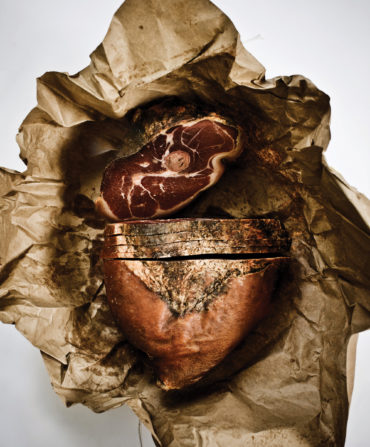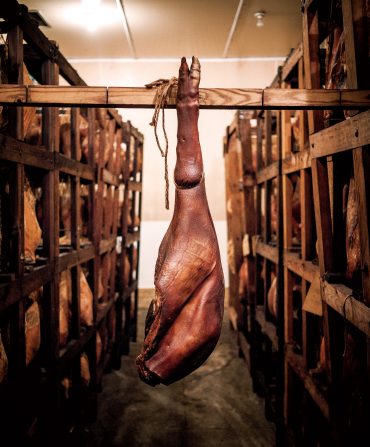Food & Drink
On the Iberico Trail
For the acclaimed Tennessee cure master Allan Benton, a trip to Spain offers a taste of country ham’s past—and a vision of its future

Photo: Peter Frank Edwards
Three hours southwest of Madrid, in the rocky and arid region of Extremadura, where oak boughs sag with acorns, crumbling Moorish castles loom, and solar arrays tilt skyward, Allan Benton, the fabled Tennessee ham and bacon curer, glimpses a possible future for Southern food. Leaning into the lunch counter at a truck stop, between bites of a sandwich layered with Spain’s prized jamón ibérico, he wonders why this sort of everyday excellence is elusive back home. “Can you imagine getting a ham sandwich like this at a truck stop in Tennessee?” he asks, working that rhetorical in his head, grappling for an answer, burnishing the possibility like a gemstone.
A clutch of drivers elbow for seats at the lunch counter to drink pony beers and fork into potato and egg tortillas. A slot machine blinks and flashes. Benton, who looks (and sounds) like a Jimmy Carter stunt double, stands before a rack of black-footed hams, sheathed in plastic netting, suspended in a wire cage that looks as if it were built to hold firearms instead of salt-cured hind legs of acorn-fattened hogs. “We’re not there yet,” he says, speaking of a South in which cheap burgers and fries are not default road foods and salt-cured artisanal hams are not relegated to special occasions. “And I may not live to see this, but maybe, someday, the kind of hams I cure will make it into truck stops.”
Benton’s name is synonymous with excellence in all things pork. Before him chefs genuflect. David Chang of the New York City–based Momofuku empire was an early advocate of his salt-and-brown-sugar-rubbed hams. Cassidee Dabney, the chef at Tennessee’s lavish Blackberry Farm, proclaims the smoky goodness of his bacon like a storefront preacher.
Yet Benton still works in a cinder-block bunker, hard by the highway in Madisonville, Tennessee, near Knoxville. Forty-plus years after curing his first ham, he answers e-mails with handwritten letters, closes business deals with handshakes, and smiles an impossibly wide grin that broadcasts warmth and welcome. When he meets someone new, at home or here in Spain, he often leads with a statement and repeats it like a mantra: “I’m a purebred hillbilly, raised so deep in a holler I had to look up to see light.” Coming from another mouth, this might sound like false modesty. But as those words drawl from Benton, they mark his honesty, humility, and pride in the place he calls home.
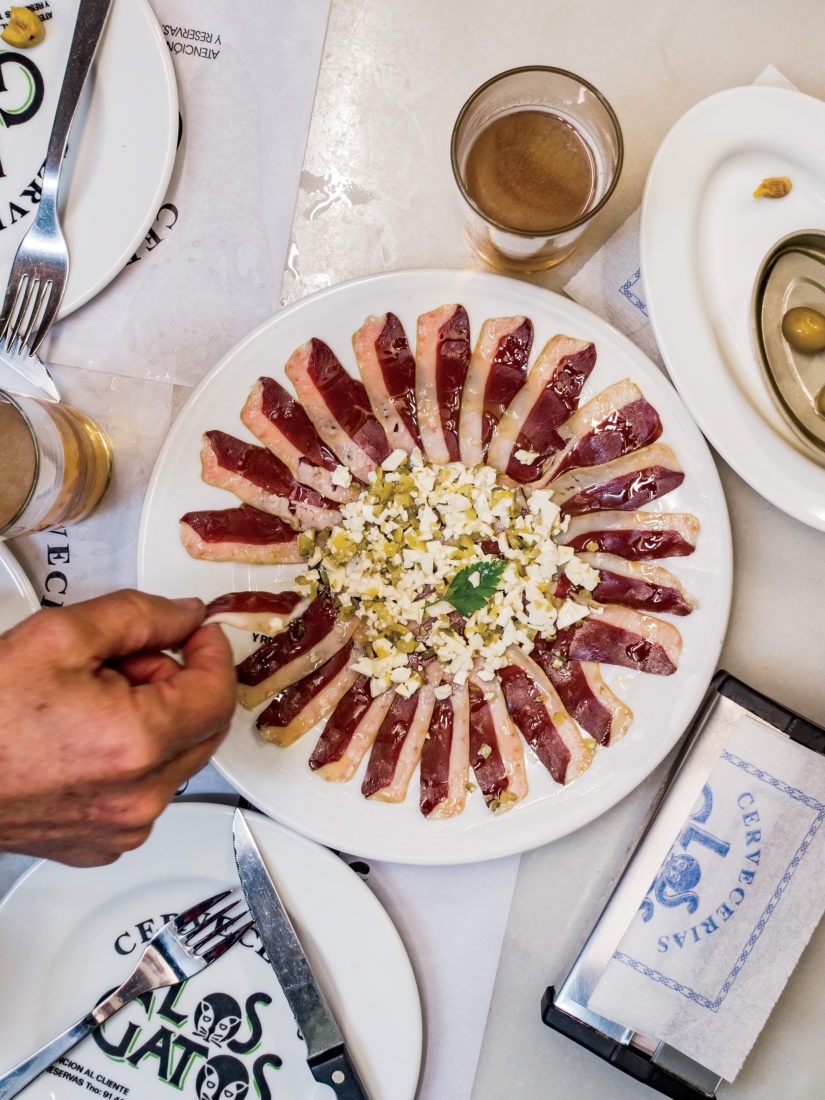
Photo: Peter Frank Edwards
A plate of cured duck ham in Madrid.
Spain is the right place to ponder the past and future of the Southern love for the pig. Spanish explorers introduced pigs to the Americas (as well as diseases that decimated the native population). When de Soto landed, he loosed Ibérico pigs from Extremadura to roam the Southern countryside. They prospered. And so did the settlers who employed Native American techniques to smoke them and adapted European traditions to salt and air-cure them. From those pigs came country ham, redeye gravy, and lard-rich cat-head biscuits. From that landing came Benton’s livelihood. Today, Spain produces the most dry-cured ham of any country in the world. By the measure of many palates, it also produces the best.
Allan flew here with Sharon, his wife of forty-two years, to grasp the roots of his craft. As he approaches his seventieth birthday, he aims to improve on the revered ham that emerges from his foothills cure house. Now, two days into a weeklong run that has taken us in and out of Madrid and down into the boulder-strewn dehesa of Extremadura, he has begun to see life back home against the backdrop of Spain.
At the truck stop, another vision comes into focus. Gazing at one of the stainless-steel racks the Spanish use to cradle hams for carving, he sketches a scene. “I can see one of these in any Southern home,” he says, peering across the bar, where a woman in a white smock carves stubby slices from a teardrop-bottomed violin of pork. Many who reach his age look back in appreciation of what they have accomplished. Or in mourning for what they have lost. Instead, Benton conjures a future.
“You could crank the ham down in there on Thanksgiving Day, and it would stay on the kitchen counter all through the holidays,” he imagines. “And you slice that ham as you need it, for suppers and parties. By the time the meat starts to disappear and you’re left with nothing but the hock and foot, it will be time to cook black-eyed peas for New Year’s Day.”
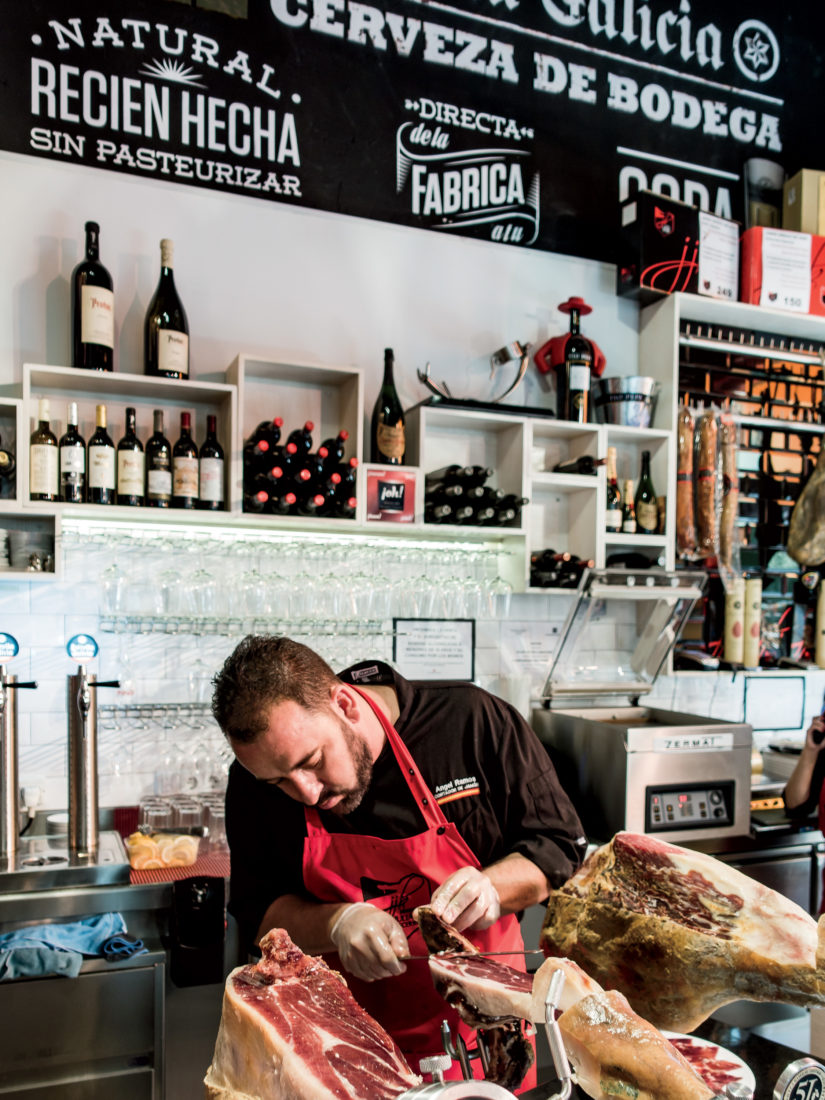
Photo: Peter Frank Edwards
Hams on display at a Madrid tapas restaurant
For centuries, ridge-backed Ibérico pigs have rooted the Extremadura grasslands, scarfing acorns beneath splayed oak canopies, taking on fall and winter weight before slaughter. Artisans here have long cured the rear legs from those pigs. Hung for two years or more, they yield ham celebrated for the nutty sweetness and silky mouthfeel of its meat and for the healthfulness of its fat, which spiderwebs the flesh, tracing marble threads through a dense field of red. Hams made from those Ibéricos bear lard that doesn’t clog arteries. Instead, the human body processes it similarly to olive oil. That’s why lovers of jamón refer to these pigs as four-legged olive trees.
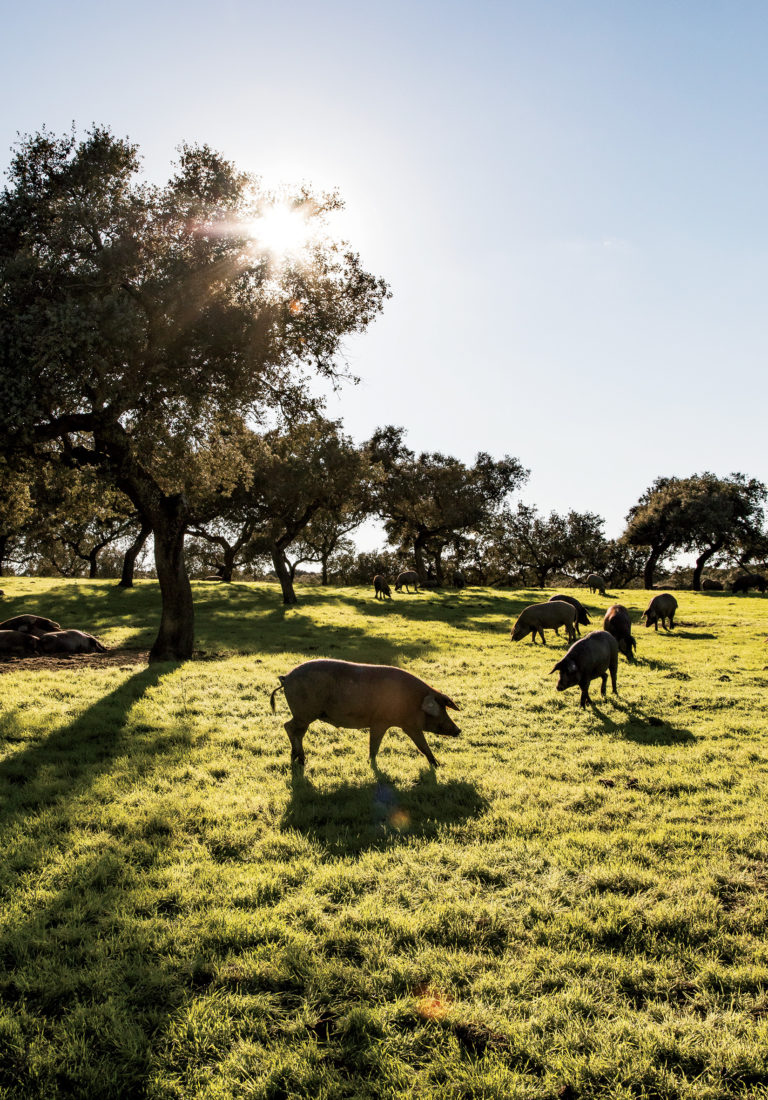
Photo: Peter Frank Edwards
Ibérico pigs amid the oaks.
Fifteen years back, when heritage-breed pigs became more widely available in America, Benton began curing hams and bellies from Durocs and Tamworths and Mangalitsas. More recently, as he learned of the superiority of Ibérico pigs, and noted that whole Ibérico hams can fetch from $500 to $2,000 in the United States, he resolved to visit their homeland, where storefront vendors style their operations as “Museos del Jamón” and all strata of society share a reverence for all things cured.
This is the first trip out of the country for Allan and Sharon. But this is not a victory-lap payoff for four decades of grindstone work. He regards the trip as a rolling workshop, a research expedition conducted in feedlots, at dining tables, and in cure houses racked floor to ceiling with salted hams.
Traveling Spain, Benton is wide-eyed and restlessly curious. His palate proves unimpeachable. Drinking rioja, he picks up the licorice blush that everyone else misses. Tasting hams, he identifies which were cured from lesser cereal-fed pigs and which came from better acorn-fed pigs. Each taste he savors, and every colleague he befriends, inspire him to ask questions of his own work.
Our party spent the first day bouncing from canteen to canteen in Madrid, drinking vermouth on the rocks, eating anchovies perched on potato chips, and sampling rosy-hued jamón shaved into matchbook planks and spiraled onto platters.
That night, Jaime Oriol, a barrel-chested attorney with a flip of white hair, joined us. A native of Madrid, Oriol worked in New York City for twenty years before returning to live in Spain, where his interests span movie financing, hog farming, and international livestock trade. In 2014, he and his son, Kurt, partnered with the pioneering Georgia farmer Will Harris of White Oak Pastures. Under the banner Iberian Pastures, they flew twenty-three mother and five boar Ibéricos from Spain to South Georgia, where Harris now raises his own four-legged olive trees.
As dinner came to a close and the waiter set down glasses of what tasted like Spanish moonshine, I sketched our plans to travel down to the town of Jabugo, where commercial jamón producers cluster. Oriol waved his hand in the air like a soccer referee signaling a red-card ejection. “There’s no need to travel there,” he shouted, screwing his face into a mask of playful contempt. “I’ll show Mr. Benton how we do it. Put the master in my hands.”
That is how, after driving three hundred kilometers south out of Madrid at close to two hundred kilometers an hour, we landed at a truck stop that serves transcendent ham sandwiches. And that is how, later that same afternoon, we arrived on a bougainvillea-draped and pomegranate-tree-flanked terrace alongside a farmworker chapel at Cobacha, the Oriol family farm compound in far southwestern Extremadura, where, our host promised, pigs root happily and oaks flush with acorns.
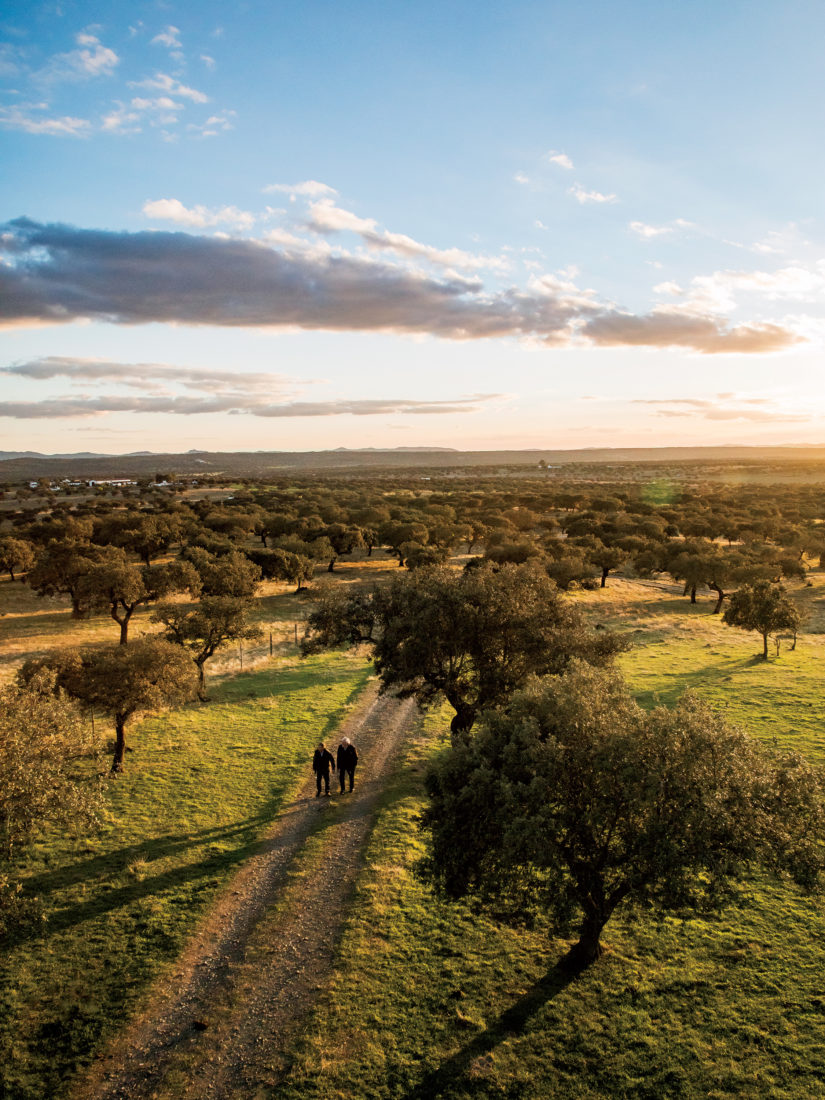
Photo: Peter Frank Edwards
Allan Benton and Jaime Oriol walk the grounds at Cobacha, Oriol’s family ranch in Spain’s Extremadura region.
>Click to see more photos from this story.
A genial wild man, Oriol sets in motion a three-day binge of hospitality and discovery, in which he assumes the role of munificent dictator, focused on feeding us Spain’s best while delivering graduate-course lectures in Spanish history, geography, culture, and politics.
Days begin at the Cobacha dining-room table, beneath an oil painting of the wave-crashed Spanish armada. Breakfasts of fried yard eggs and migas, a toss of bread crumbs and cracklings, end with oranges, plucked from trees in the courtyard. Lunches, eaten in the shadow of a Moorish castle one day, on the veranda of a grand hacienda the next, open with Torta del Casar, a local sheep’s milk cheese that turns gooey after a quick run in the oven. They close with pound cake, topped with more oranges. Somewhere around course three, Ibérico pork always shows.
At their simplest, those Ibéricos yield lunches of roasted pork shoulder, sliced into medium-rare medallions, thatched with lard-fried potatoes, presented in a wash of fat-swirled jus. In the hilltop town of Albuquerque at the restaurant El Fogón de Santa Maria, set in a stone-walled fifteenth-century cellar, local pork gains complexity. Over a long and boozy meal, a mousse of chorizo crumbles and cream, reminiscent of feral pimento cheese, precedes lozenges of baby Ibérico, roasted until the flesh turns creamy and the skin crisps to a shingle.
Evenings end on the fieldstone terrace at Cobacha, as the sun fireballs across the coral horizon, backlighting the oaks in psychedelic silhouette. “I didn’t just come to Spain,” Benton says, clasping his hands prayerfully, looking to the skies, clinking Oriol’s wineglass. “I fell into Spain.”
From their first meeting, Oriol has referred to Benton as a master. Now that he has the master in his friendly grasp, he aims to school him in jamón ibérico. And in the life ibérico.
Manuel Maldonado of Albuquerque tops Oriol’s list of Spanish cure masters. Ferran Adrià, the most famous chef in Spain and, arguably, the most influential world chef of the twenty-first century, prefers his hams, which Maldonado rubs with salt from coastal Cádiz and hangs with the hooves facing the ceiling. He is, in short, the Spanish Allan Benton.
Our crew meets Maldonado at his white masonry cure house, skirted by wizened olive trees. With the Spanish master leading the way, Benton reviews processes, tracing the path from pink haunches of freshly butchered pork to two-year-old exemplars, rubbed with olive oil until they gleam beneath the lights. After an hour of inspection, Maldonado directs us to the basement tasting room, where a spread of delicacies awaits. For Benton, he cracks open bottle after bottle of tempranillo, slices fat hunks of meat from rosy loins, cuts coins of pimentón-blushed chorizo, and shaves stub after stub of sweet ham.
While our group praises Maldonado’s handiwork, Benton stands alone in the corner, figuring percentages in his head. The USDA requires him to salt a twenty-five-pound ham for fifty days before hanging it to age, but a Spanish firm can hang the same-size ham after only twelve days. Benton decides that is why the pork he tastes this morning is sweeter and less salty than what he cures back home. That taste is not new to him. It reminds him of the acorn-fattened hams his grandparents salted and hung in Virginia two generations back, before stricter governmental regulations took effect.
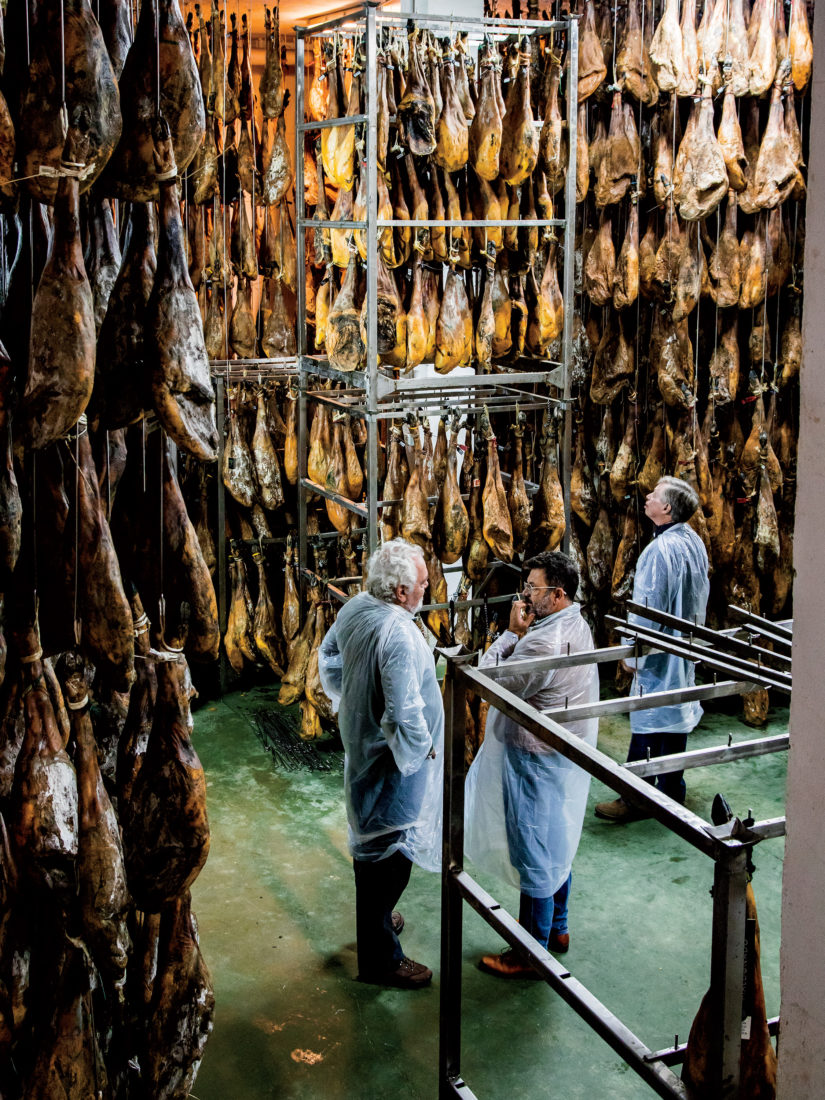
Photo: Peter Frank Edwards
Oriol (left) and cure master Manuel Maldonado confer as Benton admires the ham racks.
When Benton rests a slice of jamón on his tongue and looks up at the ceiling, Maldonado steps to his side. “There is a permanence in your mouth,” he says. “It’s not salty. It lingers. There is persistence.” Benton nods and smiles shyly, thinking of the hams that emerged from that dirt-floored Virginia smokehouse.
In Maldonado, Benton recognizes a fellow member of the artisan fraternity, divided by the Atlantic, united by a belief in the careful manipulation of salt and time. Sensing the bond, seizing the moment, Oriol leans toward Benton, smiling. “In the future you two will do business together,” he whispers. “The two masters together! I know it.”
The next morning—before we tour an industrial cure facility and, later, a farm where we watch, mesmerized, as sway-bellied Ibéricos sashay across rocky pastureland, rooting for acorns—one of the Cobacha workers meets Oriol at his car. He holds an oak tree bloom in his hand. It’s late fall now. Trees are not supposed to bloom until March, he says. When the first frost comes in a month, that oak will probably die. Global warming is a real and persistent threat in Extremadura.
Benton arrived in Spain as he began to consider changes in how he sources pigs. In Extremadura he has seen much that is ancient, and much that he would like to replicate. But he also now understands that, while the Spanish have a long head start on pig raising and ham curing, they too confront a range of challenges. Acorns, which drop from oak trees here each fall and blanket the savanna, vary year to year. Sweet one season, bursting with the nut meat on which Ibéricos feast, they can be fibrous and nutrient poor the next. As new markets for Ibérico hams have opened, demand from the United States and China has stressed supply chains. Some years, there aren’t enough acorns to feed the Ibéricos. To make matters worse, a blight sometimes hits the trees, rendering the leaves brown, the branches withered, the acorns scarce.
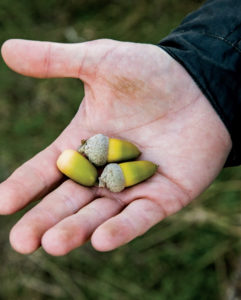
Photo: Peter Frank Edwards
The cherished acorns.
“We have been slaves to the acorn,” Oriol says, standing by a fence at Cobacha, watching baby Ibéricos scamper by like windup toys. Evidence of that reliance is everywhere at Cobacha. A bronze sculpture of a pig rooting beneath the oaks dominates a credenza opposite the fireplace. Acorns decorate the living room rugs and the service ware that graces his dining room table. While reverence for the acorn remains, the resolve to find alternatives intensifies.
Across Spain, Oriol and many of his friends have begun experimenting with feeds that might serve as substitutes or supplements to acorns, which Ibéricos typically eat in the last three months before slaughter. Benton’s grandparents, who cured the hams that set his forever standard, fed their pigs on windfall acorns. Back in Tennessee, as Benton made plans to raise his own pigs, he had begun looking for a feed that might render the same fat and flavor.
Not long before he set out on this trip, a University of Tennessee researcher confirmed his hunch that a diet of sunflower seeds might yield similar fat quality in pigs. Benton had begun to imagine how this could play out. He contacted a farmer who might raise the pigs. And he eyed a parcel of land just down the road from his cure house where they might roam freely.
Before Benton set his plan in motion, the professor advised him to wait and see what he would learn in Spain. Traveling Extremadura, he has learned that while the Spanish draw on a deeper trove of experience, they too must bridge gaps between old and new, between tradition and innovation. Watching a pack of Ibéricos root the grasslands, marveling at his good fortune to be here, now, Benton turns toward Oriol. “You are asking the same questions I am,” he says. “And I had to come all the way to Spain to meet you.”
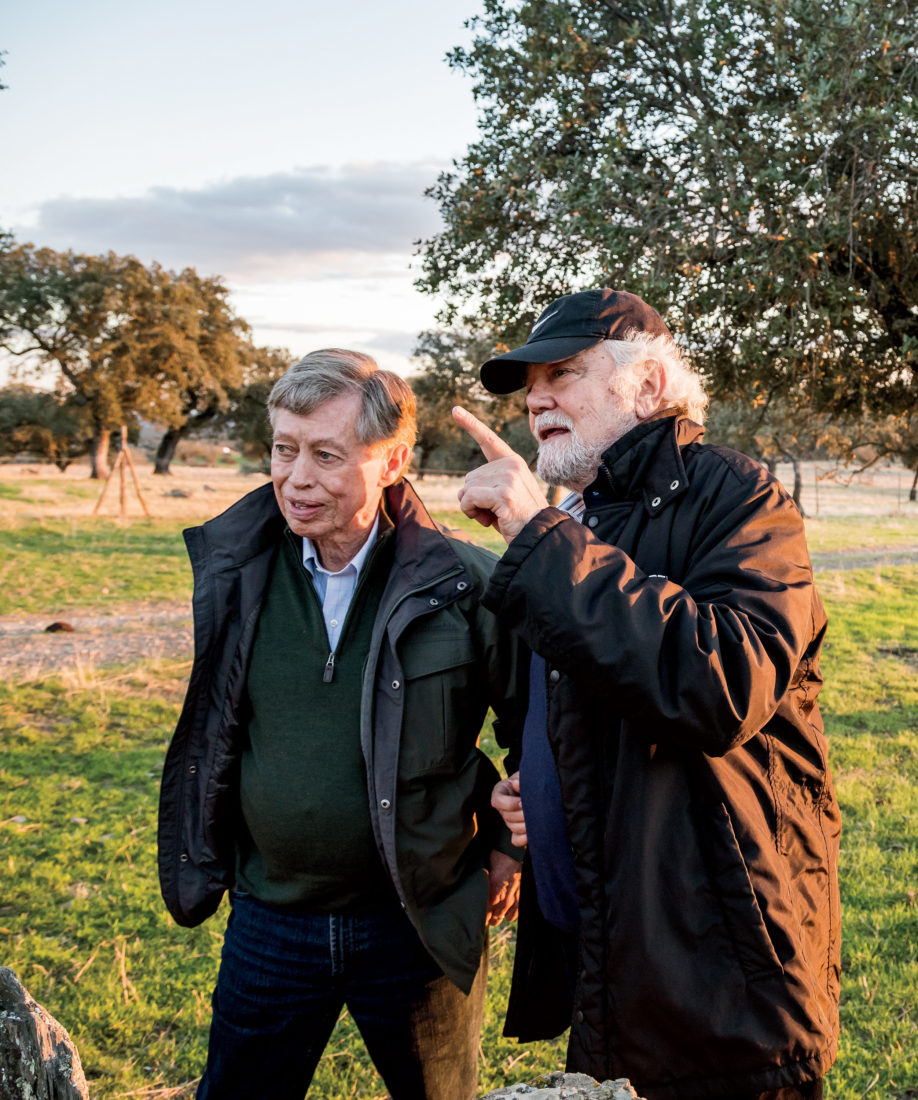
Photo: Peter Frank Edwards
Benton and Oriol at Cobacha.
Many of us dream big dreams while traveling. We resolve to study French or learn the mandolin. We conspire to buy a second home by the water or in the mountains.
Travel offers perspective. When the voting rights activist Fannie Lou Hamer journeyed to West Africa, she came home with new ideas about the power of landownership. The Birmingham, Alabama, chef Frank Stitt returned home from France, where he worked for the writer Richard Olney, with a new appreciation for Alabama farm goods. Travel through Spain has convinced Benton that his dreams of a ham-focused future are realizable. Talking with fellow masters like Maldonado, he has recognized that while Spanish ham is celebrated, what he does is rightly comparable. Tasting his way through Extremadura, he has learned to value anew the excellence of his own craft. Informed by what he has gleaned, Benton may gently rethink his techniques. But he won’t reinvent them.
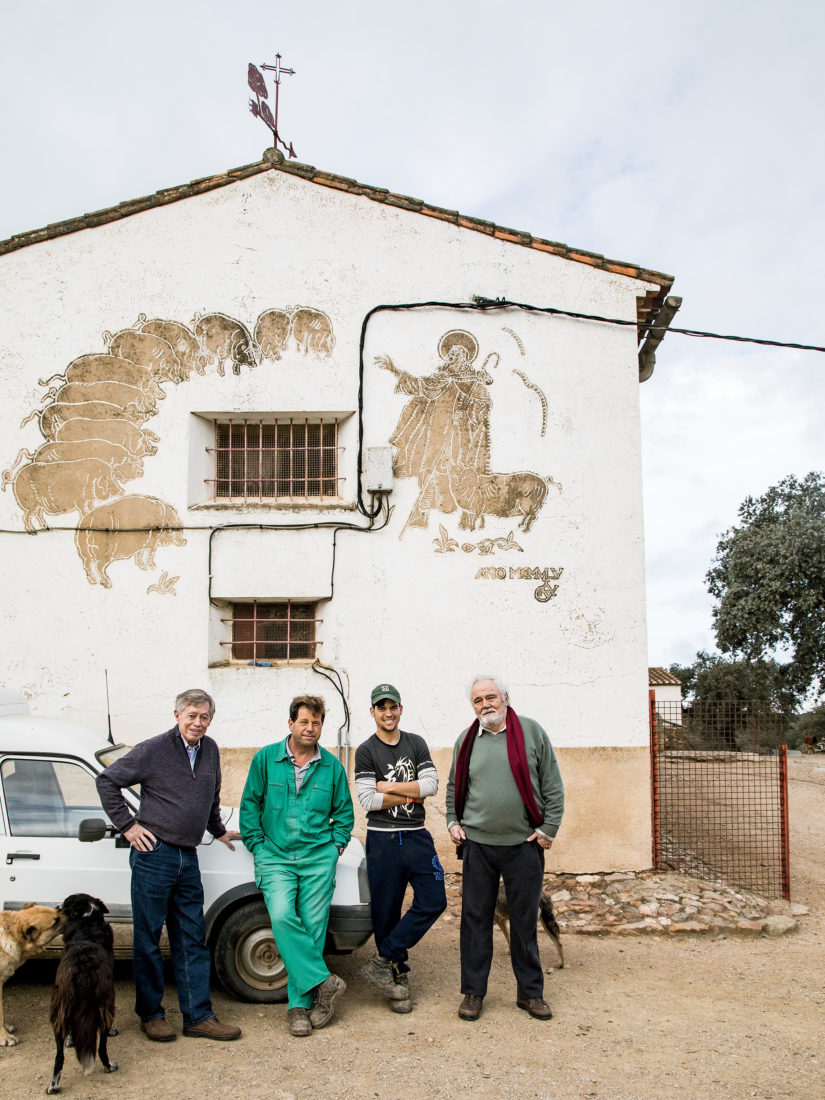
Photo: Peter Frank Edwards
Benton (left) and Oriol (right) with two farm workers outside an old farrowing barn.
Before we return to Madrid and, eventually, home, Benton loops back to Albuquerque. From Maldonado, the master, he buys ham for everyone. For his colleagues back in Madisonville. For his traveling companions. We tuck packets of the good stuff in our luggage and begin worrying whether we’ll clear U.S. customs with our prizes.
Two days and one transoceanic flight later, a customs agent in Atlanta asks Benton if he has returned with any meat products. His fellow travelers have already waltzed through the checkpoint, believing that our white lies and sins of omission were justified by the acorn-fed payoffs, when the Tennessee cure master, who values the contents of his luggage more than any of us covet ours, tells the truth. Soon, he’s unzipping his bag, rummaging through dirty socks to remove packet after packet of claret-colored jamón slices that spangle like mica beneath the fluorescents. Faced with the knowledge that his jamón may soon be bound for the trash, he makes one last effort to fix the memory of that Ibérico on his palate. “May I step aside here and just eat my ham?” he asks. That’s impossible, says the woman in the blue uniform. “If you ate that food here, you would be making this space into a restaurant.”
Back home, when Benton applies what he has learned in Spain, he won’t have Maldonado’s jamón to taste and compare. But he will have company. Will Harris and Oriol have already set a winter date to slaughter their first Georgia Ibéricos. Benton hopes to salt cure one of those prizes in Madisonville. When he does, the Tennessee cure master will rely on recollections of Extremadura, the promise of sunflower crops to come, and memories of his grandparents’ Virginia smokehouse, tucked so deep in a holler he had to look up to see sunlight.



